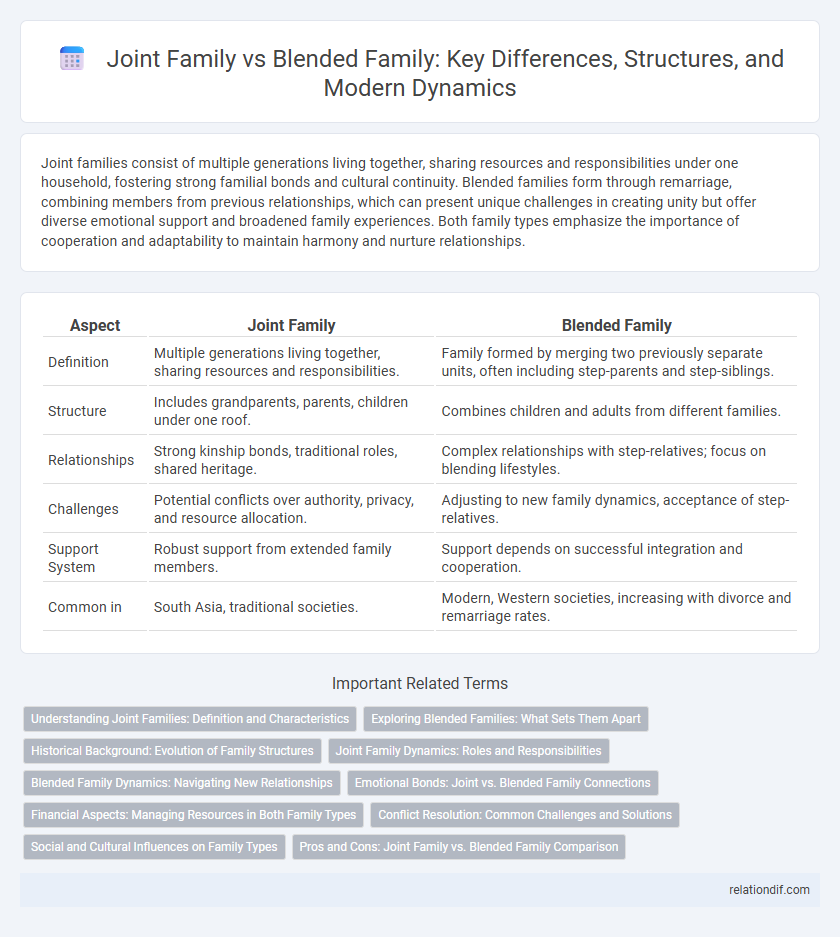Joint families consist of multiple generations living together, sharing resources and responsibilities under one household, fostering strong familial bonds and cultural continuity. Blended families form through remarriage, combining members from previous relationships, which can present unique challenges in creating unity but offer diverse emotional support and broadened family experiences. Both family types emphasize the importance of cooperation and adaptability to maintain harmony and nurture relationships.
Table of Comparison
| Aspect | Joint Family | Blended Family |
|---|---|---|
| Definition | Multiple generations living together, sharing resources and responsibilities. | Family formed by merging two previously separate units, often including step-parents and step-siblings. |
| Structure | Includes grandparents, parents, children under one roof. | Combines children and adults from different families. |
| Relationships | Strong kinship bonds, traditional roles, shared heritage. | Complex relationships with step-relatives; focus on blending lifestyles. |
| Challenges | Potential conflicts over authority, privacy, and resource allocation. | Adjusting to new family dynamics, acceptance of step-relatives. |
| Support System | Robust support from extended family members. | Support depends on successful integration and cooperation. |
| Common in | South Asia, traditional societies. | Modern, Western societies, increasing with divorce and remarriage rates. |
Understanding Joint Families: Definition and Characteristics
A joint family consists of multiple generations living under one roof, typically including grandparents, parents, children, and sometimes extended relatives, sharing resources and responsibilities. This family structure emphasizes collective decision-making, strong kinship bonds, and cultural traditions, often seen in societies with deep-rooted communal values. Economic support and caregiving are distributed among members, fostering a close-knit environment that balances individual and group needs.
Exploring Blended Families: What Sets Them Apart
Blended families consist of partners bringing children from previous relationships into a new household, creating complex family dynamics and unique emotional challenges. Unlike joint families, where multiple generations live under one roof, blended families require adapting to step-parent roles, co-parenting with ex-partners, and establishing new family traditions. Effective communication and flexibility are essential for building trust and cohesion in these evolving family structures.
Historical Background: Evolution of Family Structures
Joint families have roots in ancient agrarian societies where multiple generations lived under one roof to share resources, labor, and responsibilities, fostering economic stability and social cohesion. Blended families emerged more prominently in modern times due to rising divorce rates and remarriages, reflecting changing social norms around marriage and family dynamics. This evolution illustrates a shift from traditional lineage-based support systems toward diverse, flexible family units adapting to contemporary societal needs.
Joint Family Dynamics: Roles and Responsibilities
Joint family dynamics revolve around shared responsibilities, where multiple generations live under one roof, fostering collective decision-making and resource management. Each member typically assumes defined roles such as caregiving, financial support, and household chores, promoting interdependence and social cohesion. Respecting elders and maintaining hierarchical structures are key aspects that sustain harmony and preserve cultural values within joint families.
Blended Family Dynamics: Navigating New Relationships
Blended family dynamics involve navigating complex relationships as members from previous partnerships merge into a new household, requiring adaptability and strong communication skills. Conflicts often arise due to differing parenting styles, loyalty conflicts, and the challenge of establishing new family roles and boundaries. Successful blended families foster open dialogue, mutual respect, and time for bonding to create a cohesive and supportive environment.
Emotional Bonds: Joint vs. Blended Family Connections
Joint families foster deep emotional bonds through shared history, traditions, and continuous daily interactions among multiple generations living together. Blended families develop emotional connections by integrating diverse backgrounds and establishing new rituals, often requiring intentional communication and mutual support to strengthen relationships. Both family types emphasize trust and cooperation, though joint families benefit from longstanding ties while blended families focus on adapting and creating unity from varied experiences.
Financial Aspects: Managing Resources in Both Family Types
Joint families often benefit from pooled financial resources, enabling collective investment in property, education, and healthcare, which can lead to greater economic stability and shared responsibilities. Blended families may face complex financial dynamics involving separate budgeting and managing obligations from previous relationships, requiring clear communication and agreed-upon financial plans to ensure fairness. Efficient resource management in both family types depends on transparency, regular financial discussions, and equitable contribution strategies tailored to the specific family structure.
Conflict Resolution: Common Challenges and Solutions
In joint families, conflict resolution often involves maintaining harmony among multiple generations living together, with common challenges including differing values and authority clashes, which can be addressed through open communication and respect for elders. Blended families face unique conflicts such as adjusting to new roles and managing relationships between step-siblings and step-parents, where establishing clear boundaries and fostering trust are key solutions. Both family types benefit from regular family meetings and professional counseling to effectively navigate and resolve internal conflicts.
Social and Cultural Influences on Family Types
Joint families are deeply rooted in cultural traditions, especially in South Asian societies, where extended family living fosters strong social bonds and shared responsibilities. Blended families, increasingly common in Western cultures due to higher divorce and remarriage rates, reflect evolving social norms prioritizing individual choice and diverse family structures. Social influences such as migration, economic changes, and shifting gender roles further shape the dynamics and acceptance of joint and blended families globally.
Pros and Cons: Joint Family vs. Blended Family Comparison
Joint families offer strong emotional support and shared responsibilities but may suffer from lack of privacy and generational conflicts. Blended families foster adaptability and diverse relationships, although they often face challenges in adjusting to new family roles and potential loyalty conflicts. Comparing both, joint families emphasize tradition and collective living, while blended families prioritize flexibility and modern family dynamics.
Joint family vs Blended family Infographic

 relationdif.com
relationdif.com